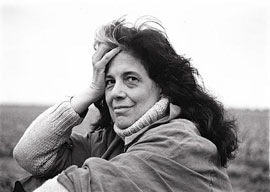
October 24, 2013

Susan Sontag
Cott, Jonathan. Susan Sontag: the Complete Rolling Stone Interview Yale University Press, 2013. 168pp. $26/£15.99
Has Sontag dated? Born in New York in 1933, she was strongly associated with the 1960s counterculture and its more anarchistic aftermath in the 1970s, and this interview combines two meetings that took place in 1978. She was then at the height of her media presence as the empress of intellectual earnestness, and her interviewer Jonathan Cott was one of the founders of Rolling Stone magazine, then at the height of its status as the world’s hippest journal. So this book had all the makings of a period piece.
On closer examination something else started to kick in. Sontag’s photo on the cover for a start: coolly beautiful and stylish, an energy in mesmeric repose. It had been taken inside Sontag’s penthouse on Riverside Drive, location of the second interview in New York. The first interview had been done five months previously in her Paris flat”which was located not in Belleville or the Latin Quarter but in the top-drawer 16th arrondissement. This blue stocking, it turns out, was also rich and chic and I”d never quite seen her in that light before.
Cott implies in his introduction that writers are usually reluctant to give interviews. I”ve conducted numerous interviews, and in my experience writers and artists are without doubt the most forthcoming, probably because they are accustomed to placing their private worlds before the public. The really uptight refuseniks are actors and pop stars. Sontag says, “I like the interview form…because I like conversation, I like dialogue….”
Maybe this fundamental extroversion is why as a student she preferred the spume of Paris to the stillness of Oxford. For her, freedom was not a condition but an appetite and could exist only in acts of assuagement: reading, looking, listening, talking, moving, thinking, questioning. But she is scornful of too much salonérie and of the writer as public clown: “…the vocation of the writer is, in some deep way, antisocial, just as it is for painters.”
The interview is now three times longer than the one originally published. Cott does not mark the translocation from Paris to New York, an error of scholarship in my view; and I suspect rather more tidying up has taken place than he reveals. It opens on a somber note”cancer”but Sontag lifts the subject, and one is immediately borne along by her careful levity, as fresh as the day it was recorded, with few references of the quaint sort. (I registered only two: Patti Smith, Erich Segal.) And she laughs a lot. Why did I think of her as a misery? Perhaps because of all that political campaigning”which however, one now sees, she was careful to keep in its place.
What first put Sontag on the map was her collection of essays Against Interpretation (1966), in which she took the attitude of her mentor Roland Barthes in ignoring barriers between high and low or popular culture, introducing that attitude to an Anglo-American audience with a bravura of her own. It was a heady mix because high culture at that time was intensely rarefied, while popular culture, with the rock revolution, was emerging from corporate clutches into something very ambitious of its own, and the two somehow met on the great highway to the future. So Sontag’s warmth, playfulness, and generosity of spirit (“I”m all for deviants”) should come as no surprise, and yet they do:
Rock and roll literally changed my life….I heard a Dionysian sound, and just as in The Bacchae, I stood up and wanted to follow.